What Does the Word Easter Stand for
For many people, Easter is primarily a family celebration with Easter egg hunts, chocolate Easter bunnies and colourful eggs. People often forget that for Christians, Easter is the oldest and highest festival in the church year. In this magazine article, we answer the most important questions about the origin, meaning and customs of Easter.
Where does the term Easter come from?
Anyone interested in the origin and meaning of the term Easter will find different explanations in the literature:
- Whether French (Pâques), Italian (Pasqua), Dutch (Pasen) or Danish (Paske): in numerous European languages there is a connection between the word for Easter and the Jewish Passover.
- In Christian doctrine, the derivation of Easter seems to come from the East. This is because the women who were the first to stand at Jesus' empty tomb were looking east towards the sunrise (Latin for "aurora").
- Supposedly, the word Easter also goes back to Ostara, the name of a Germanic goddess of spring. A pagan spring festival is said to have been named after her. However, according to linguistic experts, this never existed.
- A more recent explanation is provided by the name expert Jürgen Udolph. He establishes a connection to a North Germanic word family. In Old Norse, "ausa" means "to scoop out water, to pour", austr "to water". Accordingly, in pre-Christian times it was customary to pour water on babies and thus bless them, which was called vatni ausa. Christianity adopted the name for this, as baptism was an essential part of the early Easter festivals.
What exactly do we celebrate on Easter?
On Easter, Christians celebrate the victory of life over death with the resurrection of Jesus and thus the central event of their religion. Already the great church teacher Augustine said: "Take away the resurrection and you destroy Christianity." While Jesus' birth in the stable is, according to researchers, merely a pious legend, Easter represents a "historical" Christian festival, which the Bible also reports about in detail.
Easter in the New Testament
According to the Gospels, which mainly report on the Easter event, God alone raised his Son from the dead. However, the Bible does not describe exactly how the resurrection took place. The New Testament also does not name any eyewitnesses to this miracle. Moreover, in the Gospels we read stories about the empty tomb, the proclamation of the resurrection by an angel, apparitions of the Risen Lord and the confessions that testify to this belief. Through his resurrection, Jesus was able to remind his disciples of him by means of their faith and to commission them with a worldwide mission. The Gospels offer a diverse view of the Easter event, with each evangelist placing a different emphasis.
Relationship to Passover
What is the connection between the Christian Easter and the Jewish Passover? Jesus did not celebrate Easter with his disciples at that time, but the Jewish Passover. The festival commemorates the liberation of the people of Israel from Egyptian slavery. In the temple in Jerusalem, sacrificial animals were slaughtered, reminiscent of the slaughter of the lambs in Egypt. At the same time, the lamb was offered as a sacrifice to save the people from plagues. Each Passover pilgrim took a piece of the meat home. Seder (Hebrew for "order") was also what Jesus shared with his disciples and what Christians celebrate today as the "Last Supper" on Maundy Thursday.
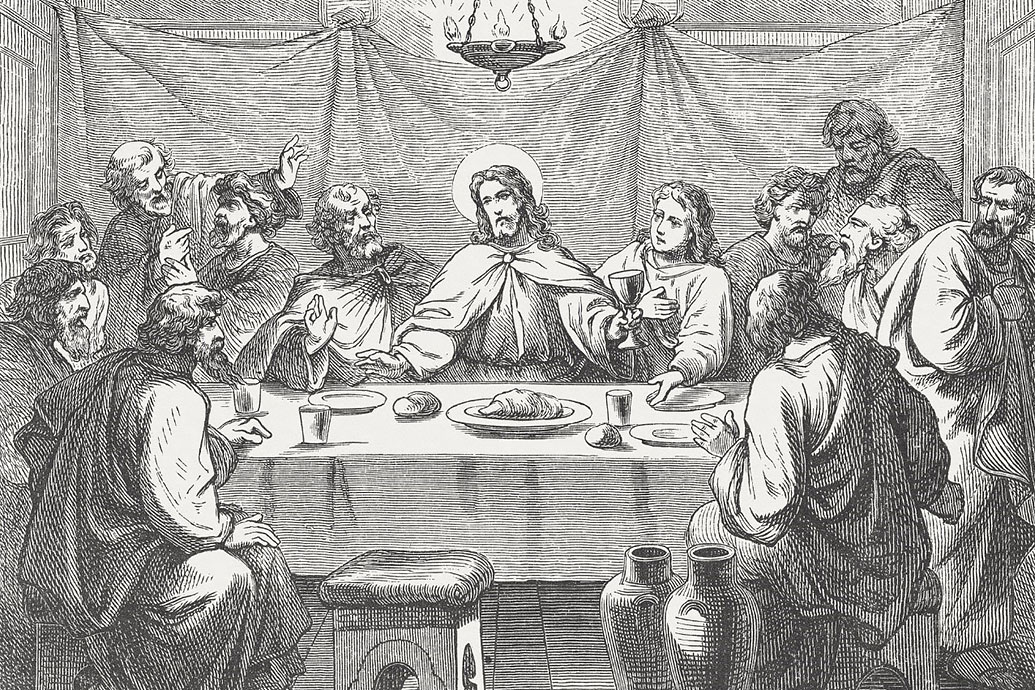 Jesus celebrates the Last Supper with his disciples.
Jesus celebrates the Last Supper with his disciples.
The Jews celebrated this every year on the 14th day of the spring month of Nisan. The evangelists Matthew, Mark and Luke report that Jesus was crucified on the main day of the Passover; in John's Gospel, he died when the Passover lambs were being slaughtered. In their depiction of the events leading up to Jesus' death, the evangelists were guided by the customs of the time.
Theologians are of the opinion that Jesus' last supper can be dated to the eve of the Passover. In Lk 22:15 Jesus says to his disciples: "I have longed to eat this Passover meal with you before I suffer".
The closeness to Judaism is particularly evident in the Easter service:
- The priest enters the dark church with the lit Easter candle, symbolising the pillar of fire that showed the Israelites the way at night during the exodus from Egyptian captivity.
- A text on the exodus of the Israelites from Egypt is read from the 2nd Book of Moses.
- In the Paschal Exsultet, the praise of Easter, the priest sings of the true Lamb, whose blood saved the people from death.
How is the date of Easter calculated?
According to an old custom, Easter Sunday always falls on the first Sunday after the first full moon of spring. According to the Gregorian calendar, this is 22 March at the earliest and 25 April at the latest. This was laid down at the Council of Nicaea in 325. This rhythm still determines the course of our year today, as Carnival and Whitsun are also tied to the date of Easter.
Below you will find an overview of the dates of Easter Sunday in the coming years:
- 2021: April 4, 2021
- 2022: April 17, 2022
- 2023: April 9, 2023
- 2024: March 31, 2024
What Easter traditions are there and where do they come from?
All of us, whether Christians or non-Christians, associate Easter above all with a rich set of customs related to the awakening of nature in spring: chocolate bunnies, colourful Easter eggs, Easter lambs and more. But what relationship do these centuries-old Easter traditions have to Easter?
Why is there an Easter bunny?
 The Easter bunny as an Easter symbol stands for fertility and thus for life.
The Easter bunny as an Easter symbol stands for fertility and thus for life.
The Easter bunny is the Easter symbol for excellence, not only on the Easter table or in the Easter nest of the children. Why a hare has become so popular is explained by the fact that hares stand for fertility and thus for life. They therefore refer to the resurrection as the central Easter event. In Byzantine animal symbolism, the hare is also a symbol of Jesus Christ.
Why do we celebrate Easter with eggs?
Easter and Easter eggs - they belong inseparably together. According to the author Georg Lohmeier, the Easter egg is not a pagan symbol, but a Christian one, as he writes in his book "The Anger of a Christian Man". Easter eggs have been consecrated for over 1600 years.
The egg has always been a symbol of fertility and rebirth in many cultures. In ancient Greece and Rome, colourful eggs were given as gifts to celebrate the spring equinox. On these days, the egg was revered as a sacred symbol of a new beginning. Christianity later adopted this ancient symbolism and gave it a special meaning: The chick that freshly hatches from the egg reminds us of the resurrection of Jesus on Easter Sunday.
What is the Easter egg hunt all about?
According to a survey, the Easter egg hunt is one of the most popular Easter customs for 24% of respondents. But where does this custom come from? Presumably, this tradition is of pagan origin. In order to pay homage to Ostara, the goddess of spring, people gave away decorated and coloured eggs. When Christianity became the accepted religion, the tradition was banned. However, since people still wanted to give each other eggs, they were secretly hidden in a field.
What is the significance of the Easter lamb?
 Sweet Easter lambs should not be missing on any laid Easter table.
Sweet Easter lambs should not be missing on any laid Easter table.
The custom of the Easter lamb goes back to the Jewish Passover, when a lamb is sacrificed to the glory of God and prepared according to strict rules. Jesus was also Jewish and celebrated Passover with his disciples. At the Last Supper, in view of the approaching death, he called himself the "Lamb of God" (Agnus Dei): "Behold, the Lamb of God who takes away the sin of the world" (Jn 1:29). This refers to the death and resurrection of Jesus, through which he gave salvation to humanity. This is why we often encounter the paschal lamb as a symbol at Easter, because it is precisely this redemptive event that is central to the Easter celebration. In many families it is customary to give small gifts in the form of the Easter lamb or to eat baked Easter lambs at Easter breakfast.
Where does the custom of dyeing Easter eggs come from?
 Dyeing and decorating chicken eggs is an important Easter custom.
Dyeing and decorating chicken eggs is an important Easter custom.
What would Easter be without coloured eggs? Coloured eggs have been known in Germany since the 13th century. There are two theories about the custom of dyeing Easter eggs:
- According to one theory, Christians dyed the eggs consecrated at Easter red to distinguish them from the unconsecrated eggs. The colour red is a reminder of Jesus' sacrificial death on the cross.
- In former times, no animal products were allowed to be eaten during Lent, but the eggs laid by the chickens were not to be thrown away, so they were hard-boiled to make them last longer. In order not to confuse the raw eggs with the cooked ones, onion peelings or beetroot, for example, were added to the cooking water and the eggs were coloured.
Where does the tradition of the Easter cot come from?
The tradition of the Easter cot, which focuses on the tragic end of Jesus' life story, dates back to the 18th and 19th centuries. At that time, the so-called Passion Nativity was widespread before it increasingly fell into oblivion in Europe. The Easter cot is a wonderful way of presenting the biblical background of Easter to interested people in a simple way through various scenes (Jesus' entry into Jerusalem, Maundy Thursday, the crucifixion on Good Friday, etc.).
You can read more about the Easter cot and its scenes and figures in our article: The Easter nativity: history and meaning.
What is the significance of the holidays before and after Easter?
The preparation time for Easter already begins on Ash Wednesday, the actual Easter period lasts from Easter Sunday to Pentecost. We have taken a closer look at the significance of the individual holidays around Easter.
Ash Wednesday
Ash Wednesday marks the end of the cheerful carnival season and the beginning of the serious and depriving Lent. Through renunciation and reflection, the faithful prepare for Easter for 40 days. Jesus serves as a model for them, as he himself persevered in the desert without food or drink and resisted the temptations of the devil (Mt 4:1-2). Ash Wednesday is a day of strict fasting and abstinence - meat is taboo on this day. Furthermore, only a single satiation is allowed, as well as a small snack in the morning and in the evening.
Palm Sunday
Palm Sunday is the prelude to Holy Week or Passion Week and recalls Jesus' entry into Jerusalem (Mt 21:1-11), where he wanted to celebrate the Passover with his disciples. The longed-for King of Peace was received jubilantly as the "Son of David". The people showed their reverence by spreading palm branches before him in the street. They hoped he would free them from Roman occupation. Jesus' popularity was a thorn in the side of the Romans. They feared he might become too powerful.
In memory of the events in Jerusalem, the faithful have palm or olive branches blessed on Palm Sunday. Afterwards, they go into the church in a solemn procession. After mass, following an old custom, the consecrated palm branches are taken home and placed behind a crucifix, for example, or attached to home altars or images of saints.

Modern Christ from 19 €
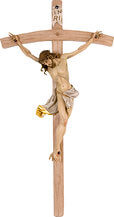
Christ A with Cross from 14 €
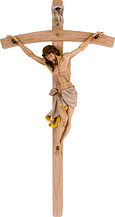
Christ C with Cross from 57 €
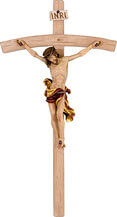
Christ Gardena with Cross from 59 €
Maundy Thursday
Maundy Thursday marks the beginning of the three Holy Days in the narrower sense - the so-called Triduum Sacrum (Latin for "holy three days"). According to biblical tradition, Jesus celebrated the Passover with his disciples on the eve of his arrest. He asked them to celebrate the Lord's Supper together in his memory. Jesus already knew that one of the twelve apostles would betray him to the Romans (Mt 26:21). As a sign of charity, he even washed his disciples' feet (Jn 13:5-15).
On Maundy Thursday, Catholics also celebrate the Mass of the Last Supper. During this service, the priest symbolically washes the feet of some of the faithful - just as Jesus did with his disciples.
By the way: the name Maundy Thursday is not derived from the colour green, but probably from the Old High German "Grunen", meaning to weep or cry.
Good Friday
The name Good Friday is derived from the Old High German word "kara", meaning lament or mourning. It is the first day of the holy three days that symbolise the central message of the Christian faith of the suffering, death and resurrection of Jesus Christ.
On Good Friday, Jesus was condemned to death and crucified by the Roman governor in Judea, Pontius Pilate. According to biblical tradition, other condemned people also died on the cross with Jesus. Since the 15th hour of the day is considered to be the hour of his death, Good Friday liturgies also take place at this time.
Throughout the ages, people have made offerings to God to honour him, to thank him or to make atonement for their sins. In the Old Testament, such sacrifices were required by God himself. Jesus sacrificed himself on the cross to the Father on Good Friday for all people. Through his suffering and death he redeemed us from original sin, from our own sins and from eternal damnation. This one sacrifice is made present at every Holy Mass in the celebration of the Eucharist.
Reflection, silence and fasting mark the day, accordingly it is sometimes called "Silent Friday". On the day of Jesus' death, Catholics walk the station of his way to the cross in order to visualise his path to death.
For Protestant Christians, Good Friday has been one of the highest holidays since the 19th century, since Jesus' death, not his resurrection from the dead, is supposed to have redeemed people from original sin.
Holy Saturday
Holy Saturday is the last day of Holy Week and the second day of the holy three days. Holy Saturday is sometimes called Silent Saturday, because the church bells are silent and there is no service. It is the day of the Holy Sepulchre, when believers focus on the grief and pain of Jesus' crucifixion.
Easter Sunday
With the beginning of the celebration of the Easter Vigil, the 40-day period of Lent comes to an end in the morning on Easter Sunday. On Easter Sunday, Christians celebrate the resurrection of Jesus and the victory of life over death. Easter is the highest celebration of Christianity. Because the resurrection establishes the belief in life after death.
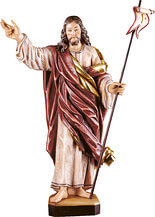
Christ Resurrector from 231 €

Resurrection from 105 €
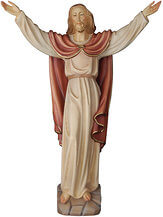
Christ resurrected from 48 €
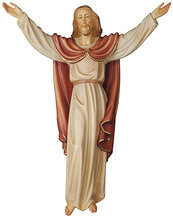
Christ resurrected for wall from 48 €
Easter Monday
Easter Monday commemorates the two disciples who set out on the road to Emmaus on the day after the Resurrection. On the way, they met the Risen Lord, who made himself known to them. Afterwards they spread the news of the resurrection with full joy (Lk 24:13-29). Thus, according to former Pope Benedict XVI, the history of Christianity as that of a faith had begun. From that moment on, the Church could be formed as the community of believers in Christ.
Pentecost
The Easter season of joy begins on the morning of Easter Sunday and does not end until 50 days later with Pentecost, the feast of the Holy Spirit. The first eight days after Easter form the so-called Easter Octave, an eight-day festival week.
Easter means the celebration of hope
Why do we celebrate Easter? Christians around the world celebrate the resurrection of Jesus from the dead on Easter Sunday and thus the foundation of the Christian faith. The resurrection gives them hope for eternal life. Thus, Easter is also called the festival of hope by believers. "Whoever knows Easter cannot despair," the theologian Dietrich Bonhoeffer once said in dark times.
Credits: Title image: ©gettyimages/luchschen, image 1: ©gettyimages/ZU_09, image 2: ©gettyimages/"Claudia Rehm, Red Chopsticks Images", image 3: ©gettyimages/GMVozd, image 4: ©gettyimages/Sitthipong Chuanpo/EyeEm.
What Does the Word Easter Stand for
Source: https://www.lignoma.com/en/magazine/why-do-we-celebrate-easter-the-meaning-and-traditions-of-easter/
0 Response to "What Does the Word Easter Stand for"
Post a Comment